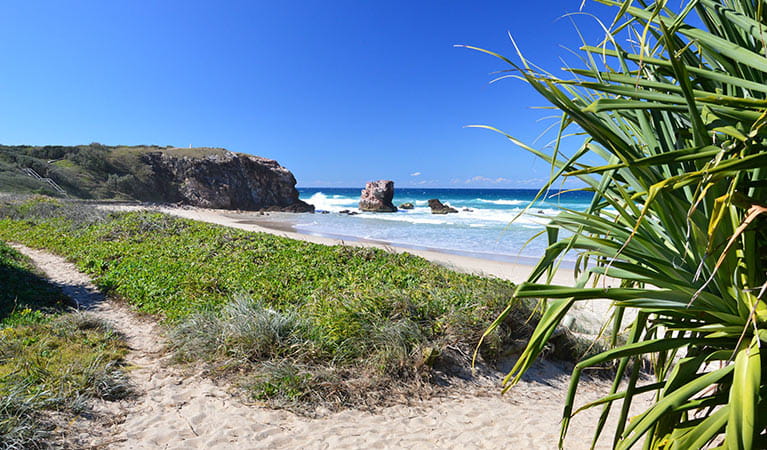Coffs Harbour bushcare and landcare
Coffs Coast Regional Park
Overview
Are you local to the Coffs Harbour area and interested in helping to protect and preserve this important stretch of NSW coastline? Volunteer to help regenerate the bush with one of 22 volunteer groups running in the Coffs Harbour area, all the way from Valla Beach to Arrawarra.
- Work
- Bush regeneration, weed and pest management
- When
Groups meet weekly, fortnightly or monthly, usually from 8.30am–12pm.
- Where
- Coffs Coast Regional Park in North Coast
- Grade
- Medium
There are volunteer groups running all along the Coffs Harbour area including at Diggers Beach, Hearns Lake, Mullaway, Safety Beach, Woolgoolga Back Beach, Emerald Beach, Korora Beach, Sawtell and Sapphire Beach.
Volunteer groups do everything from dunecare on the beach, to bushcare in inland rainforests. Bush regeneration involves many activities, but the main one is weeding. The removal of weeds allows for regeneration of Australian native plants which, in turn, creates the natural habitat necessary to support native Australian animals.
By participating in this volunteer work, you’ll be in the fresh open air alongside friendly, like-minded individuals, get a bit of exercise at the same time, and help protect Coffs Harbour’s natural habitat.
Contact us to find out which group would be most suitable for you. You don’t need any experience, and you’ll receive information, training, tools and support.
Local alerts
For the latest updates on fires, closures and other alerts in this area, see https://www.nationalparks.nsw.gov.au/things-to-do/volunteer-activities/coffs-harbour-bushcare/local-alerts
Park info
- in Coffs Coast Regional Park in the North Coast region
Coffs Coast Regional Park is always open but may have to close at times due to poor weather or fire danger.
Visitor info
All the practical information you need to know about Coffs Harbour bushcare and landcare.
Getting there and parking
Get driving directions
Coffs Coast Regional Park is accessible in several places from the Pacific Highway. The largest sections of the park are at Diggers, Beach Arrawarra and Woolgoolga.
By bike
Check out the Bicycle information for NSW website for more information.
Maps and downloads
Learn more
Coffs Harbour bushcare and landcare is in Coffs Coast Regional Park. Here are just some of the reasons why this park is special:
Life’s a beach
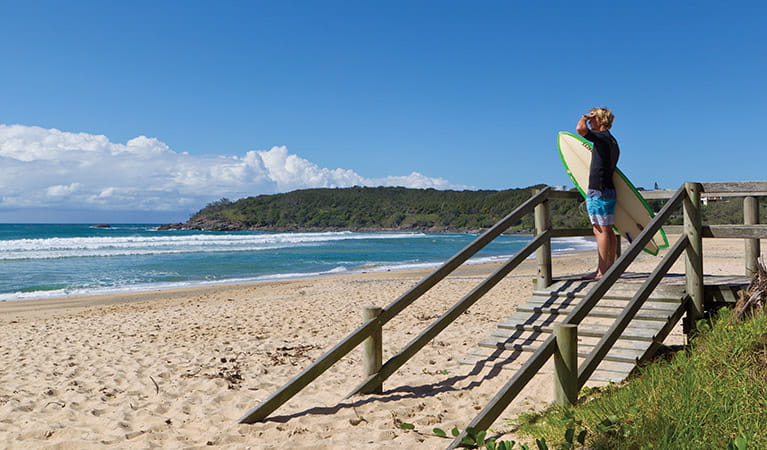
Golden beaches are the park’s premier attraction. Here, everything revolves around the water – whether you’re swimming and surfing in it, or walking and fishing beside it. Spend your days discovering the headland walking tracks, boat ramps, parklands and playgrounds. And no matter where you go, you’re bound to find a perfect spot for a beachside picnic. There are also plenty of dog-friendly areas at Coffs Coast Regional Park – just another of its popular features. Take your dog for a walk along one of the coastal paths, plus, there are several beaches with leash-free zones, meaning your pooch can zip about and enjoy the sand and sea as much as you do. The leash-free area around Corindi and Pipeclay beaches is a local favourite.
- Arrawarra Headland Soak up views of Solitary Islands Marine Park from Arrawarra Headland and Beach near Coffs Harbour. Fishing, surfing, swimming – it’s all here waiting for you to enjoy.
- Diggers Beach Located opposite the Big Banana in Coffs Harbour, Diggers Beach is excellent for surfing and learning to surf, plus fishing, swimming, birdwatching and beach walking.
- Emerald Beach Positioned near Look-at-me-now Headland, 20km from Coffs Harbour, Emerald Beach is a local surfing hotspot. Visit also for fishing or swimming, or for barbecues in the picnic area.
- Mullaway Beach and Headland Head south from Arrawarra to discover beautiful Mullaway Headland and Beach, near Coffs Harbour. Make the most of its picnic area and barbecues, go fishing or swimming.
Whale watchers
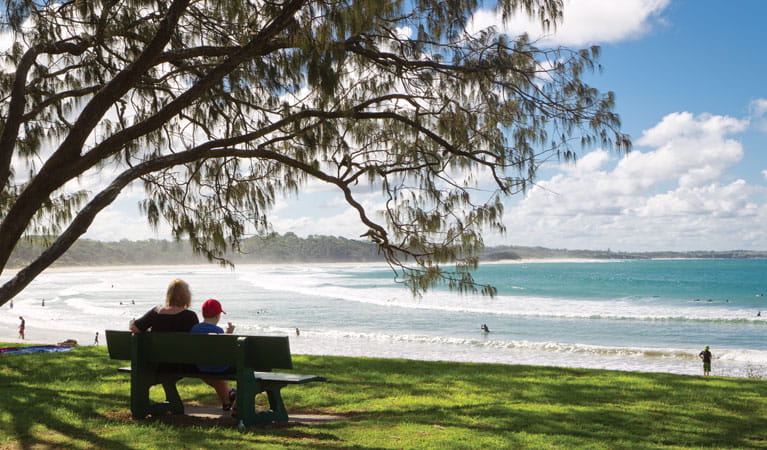
Coffs Coast Regional Park is a fantastic place to enjoy watching these majestic creatures on their long coastal journey. Look-At-Me-Now Headland near Emerald Beach is a great vantage point, but locals agree Woolgoolga Headland is your best bet for glimpsing humpbacks. In fact, it’s also known as ‘Whale Watch Headland’. Plan a trip between June and October to see this inspiring sight.
- Whale watching at Woolgoolga Join our NPWS guides for a free whale watching experience on the Coffs Coast. It's whale watching season – see how many whales you can spot out deep! Great for all ages.
- Woolgoolga Beach and Headland Woolgoolga Beach and Headland has the best whale watching in the Coffs Region, plus great surfing, fishing and picnics and scenic views.
Plants and animals protected in this park
Animals
-

White-bellied sea eagle (Haliaeetus leucogaster)
White-bellied sea eagles can be easily identified by their white tail and dark grey wings. These raptors are often spotted cruising the coastal breezes throughout Australia, and make for some scenic bird watching. Powerful Australian birds of prey, they are known to mate for life, and return each year to the same nest to breed.
-
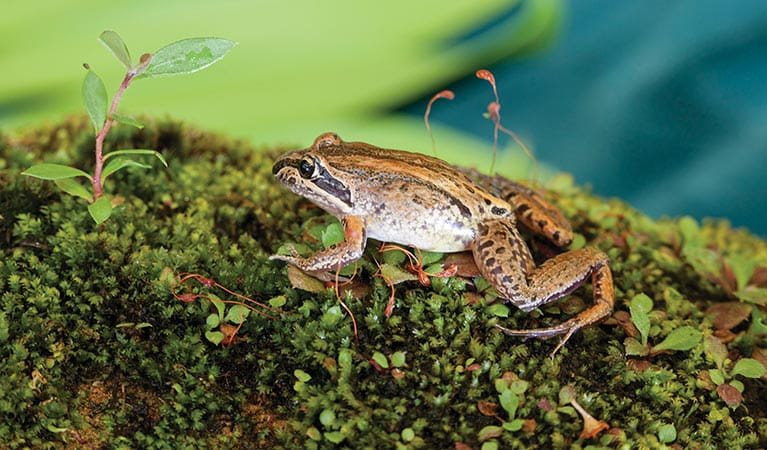
Brown-striped frog (Lymnastes peronii)
One of the most common frogs found in Australia, the ground-dwelling brown-striped frog lives in ponds, dams and swamps along the east coast. Also known as the striped marsh frog, this amphibian grows to 6.5cm across and has a distinctive ‘tok’ call that can be heard all year round.
-
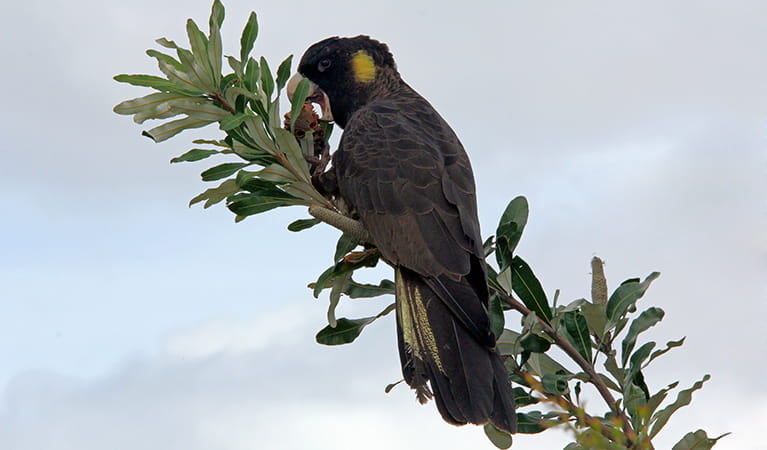
Yellow-tailed black cockatoo (Calyptorhynchus funereus)
The yellow-tailed black cockatoo is one of the largest species of parrot. With dusty-black plumage, they have a yellow tail and cheek patch. They’re easily spotted while bird watching, as they feed on seeds in native forests and pine plantations.
-
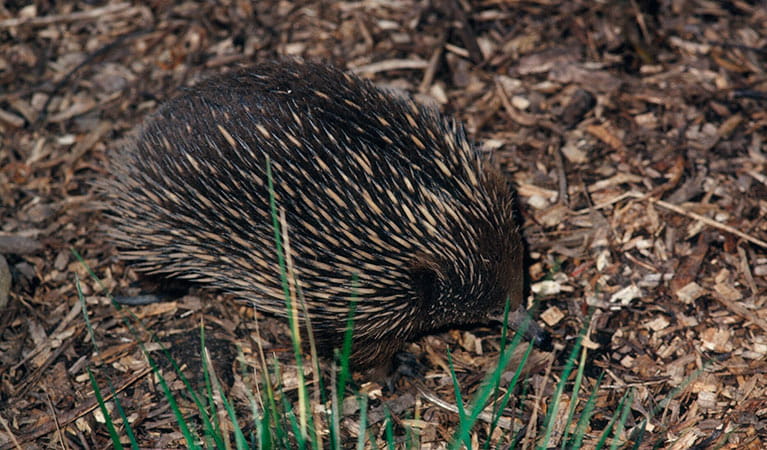
Short-beaked echidna (Tachyglossus aculeatus)
One of only 2 egg-laying mammals in the world, the short-beaked echidna is one of the most widespread of Australian native animals. Covered in spines, or quills, they’re equipped with a keen sense of smell and a tube-like snout which they use to break apart termite mounds in search of ants.
-
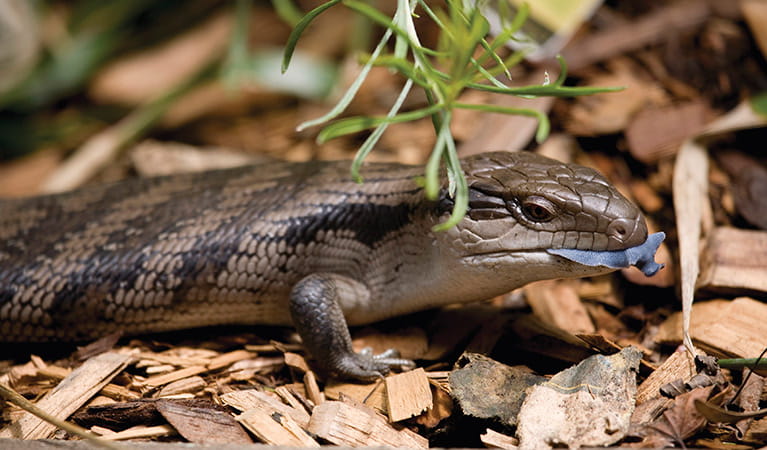
Eastern blue-tongue lizard (Tiliqua scinciodes)
The eastern blue-tongue lizard, one of the largest skinks in Australia, is found throughout most of NSW. When threatened, the eastern blue-tongue lizard displays its blue tongue in a wide-mouthed intimidating show. Not an agile animal, they feed on slow-moving beetles and snails.

